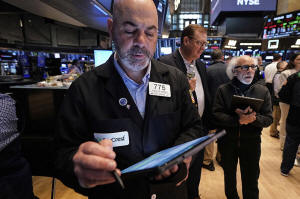Stocks drift to a mixed close as worries about the US government's
soaring debt continue to weigh
[May 23, 2025] By
DAMIAN J. TROISE
NEW YORK (AP) — Stocks drifted to a mixed close on Wall Street Thursday
in what has been a rocky week so far because of worries coming out of
the bond market about the U.S. government’s mounting debt.
Trading remained choppy throughout most of the day following Wednesday’s
big slump for the S&P 500. That loss has put the benchmark index on
track for its worst week in the last seven.
The S&P 500 slipped 2.60 points, or less than 0.1%, to close at
5,842.01. The Dow Jones Industrial Average fell 1.35 points, or less
than 0.1%, to 41,859.09. The Nasdaq composite rose 53.09 points, or 0.3%
to 18,925.73.
Technology stocks did most of the heavy lifting for the broader market.
The majority of stocks within the S&P 500 lost ground, but gains for
technology companies with outsized values offset those losses. Google’s
parent Alphabet jumped 1.4% and Nvidia rose 0.8%.
The choppy trading this week and sharp decline for stocks on Wednesday
follows several weeks of mostly gains that have brought the S&P 500 back
within 5% of its all-time high.
“We've had a good bounce here, but the market is looking for some excuse
to take some money off the table,” said Scott Wren, senior global market
strategist at Wells Fargo Investment Institute.
Treasury yields held a bit steadier in the bond market, but only after
oscillating earlier in the morning after the House of Representatives
approved a bill that would cut taxes and could add trillions of dollars
to the U.S. debt. The bond market has been the epicenter of Wall
Street’s action this week. Yields have been broadly on the rise in part
because of worries about the U.S. government’s spiraling debt.

Besides making it more expensive for the U.S. government to borrow to
pay its bills, higher Treasury yields can also filter into the rest of
the economy and make it tougher for U.S. households and businesses to
get their own loans. Higher yields also discourage investors from paying
high prices for stocks and other investments.
The yield on the 10-year Treasury climbed as high as 4.63% before the
U.S. stock market opened for trading, before receding to 4.54%. It stood
at 4.58% late Wednesday and was as low as 4.01% early last month. The
two-year yield, which more closely tracks expectations for action by the
Federal Reserve, slipped to 3.99% from 4.02% late Wednesday.
The House’s multitrillion-dollar spending bill, which aims to extend
some $4.5 trillion in tax breaks from President Donald Trump’s first
term while adding others, is expected to undergo some changes when it
gets to the Senate for a vote.
The legislation also includes a speedier rollback of production tax
credits for clean electricity projects, which sent shares of solar
companies tumbling. Sunrun dropped 37.1%, Enphase Energy fell 19.6% and
First Solar slid 4.3%.

[to top of second column] |

Traders Fred Demarco, left, and Peter Tuchman, right, work on the
floor of the New York Stock Exchange, Tuesday, May 20, 2025. (AP
Photo/Richard Drew)

Health care stocks also fell Thursday after the Centers for Medicare &
Medicaid Services said it was immediately expanding its auditing of
Medicare Advantage plans. UnitedHealth Group fell 2.1% and Humana lost
7.6%.
Wall Street had several economic updates on Thursday.
The number of Americans filing unemployment claims last week fell
slightly. The broader employment market has remained strong, though
businesses remain worried about the economic uncertainty amid a trade
war.
The market had briefly turned higher earlier in the day following a
better-than-expected report on manufacturing and services in the U.S.
The survey from S&P Global showed growth for both areas in May following
a sluggish April.
“Business confidence has improved in May from the worrying slump seen in
April, with gloom about prospects for the year ahead lifting somewhat
thanks largely to the pause on higher rate tariffs,” said Chris
Williamson, chief business economist at S&P Global Market Intelligence.
The report also reflected the impact of the trade war on supply chains,
prices and concerns about the economic picture moving forward. New
orders from businesses were the big driver for the improvement, but much
of that was from businesses trying to get ahead of a potentially hefty
round of tariffs that could hit the economy in July.
“Concerns over tariff-related supply shortages and price rises led to
the largest accumulation of input inventories recorded since survey data
were first available 18 years ago,” Williamson said.
A 90-day pause on some of President Donald Trump’s heftiest tariffs
helped give some businesses and consumers some relief. They are already
contending with broad tariffs and their impact on prices for a wide
range of goods coming from trading partners around the world, including
China, Canada and Mexico.
The overall rise in prices charged for goods and services in May was the
steepest since August 2022, according to the S&P Global report.
Businesses have been warning investors about higher costs because of
tariffs, prompting many to trim or pull financial forecasts. Many of
them, including retail giant Walmart, have also warned consumers that
they are raising prices on a wide range of goods because of higher
import taxes.
In stock markets abroad, indexes fell across Europe and Asia. France’s
CAC 40 dropped 0.6%, Hong Kong’s Hang Seng fell 1.2% and South Korea’s
Kospi slid 1.2% for some of the sharper losses.
___
AP Business Writers Stan Choe, Matt Ott and Yuri Kageyama contributed.
All contents © copyright 2025 Associated Press. All rights reserved |